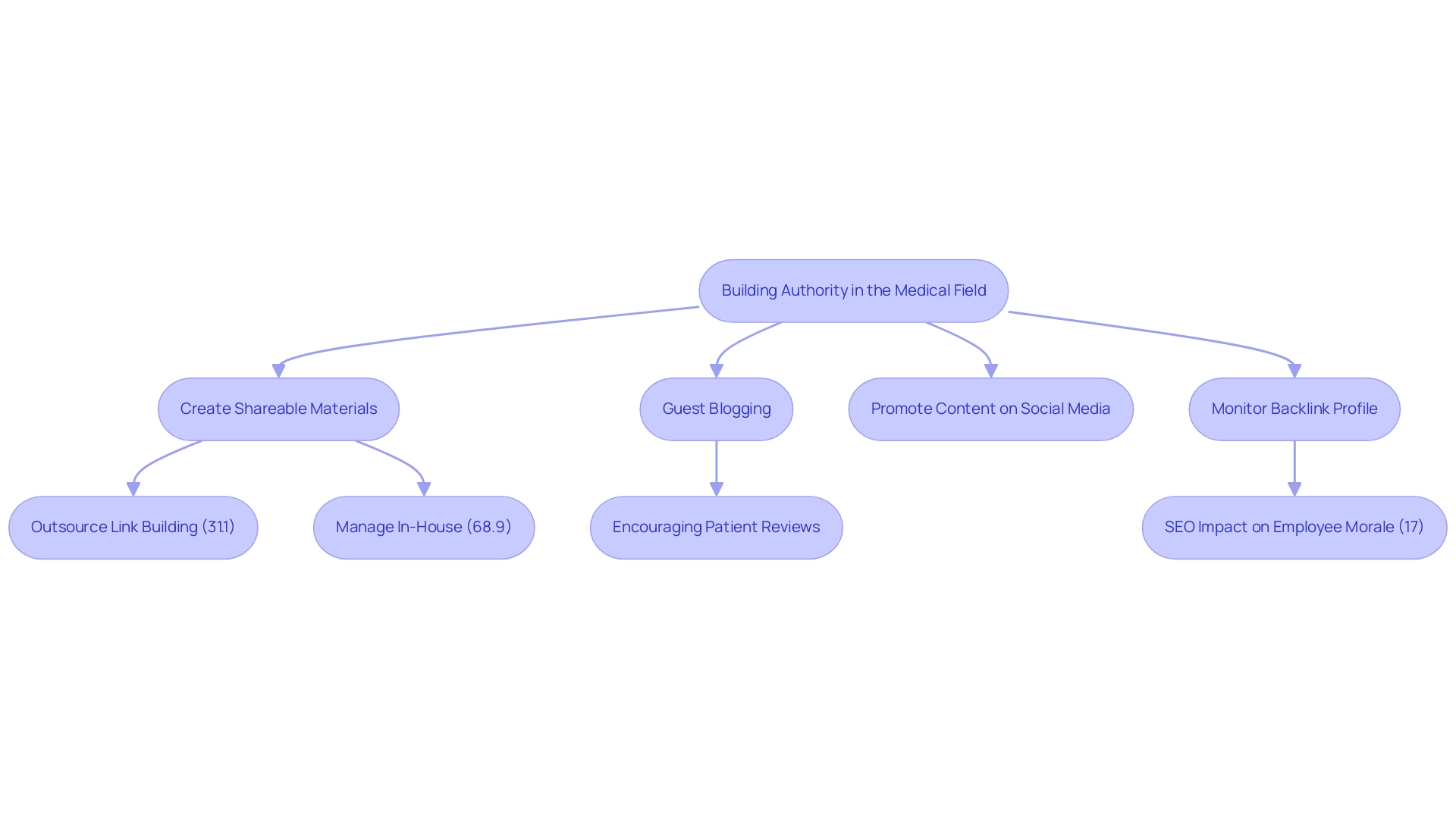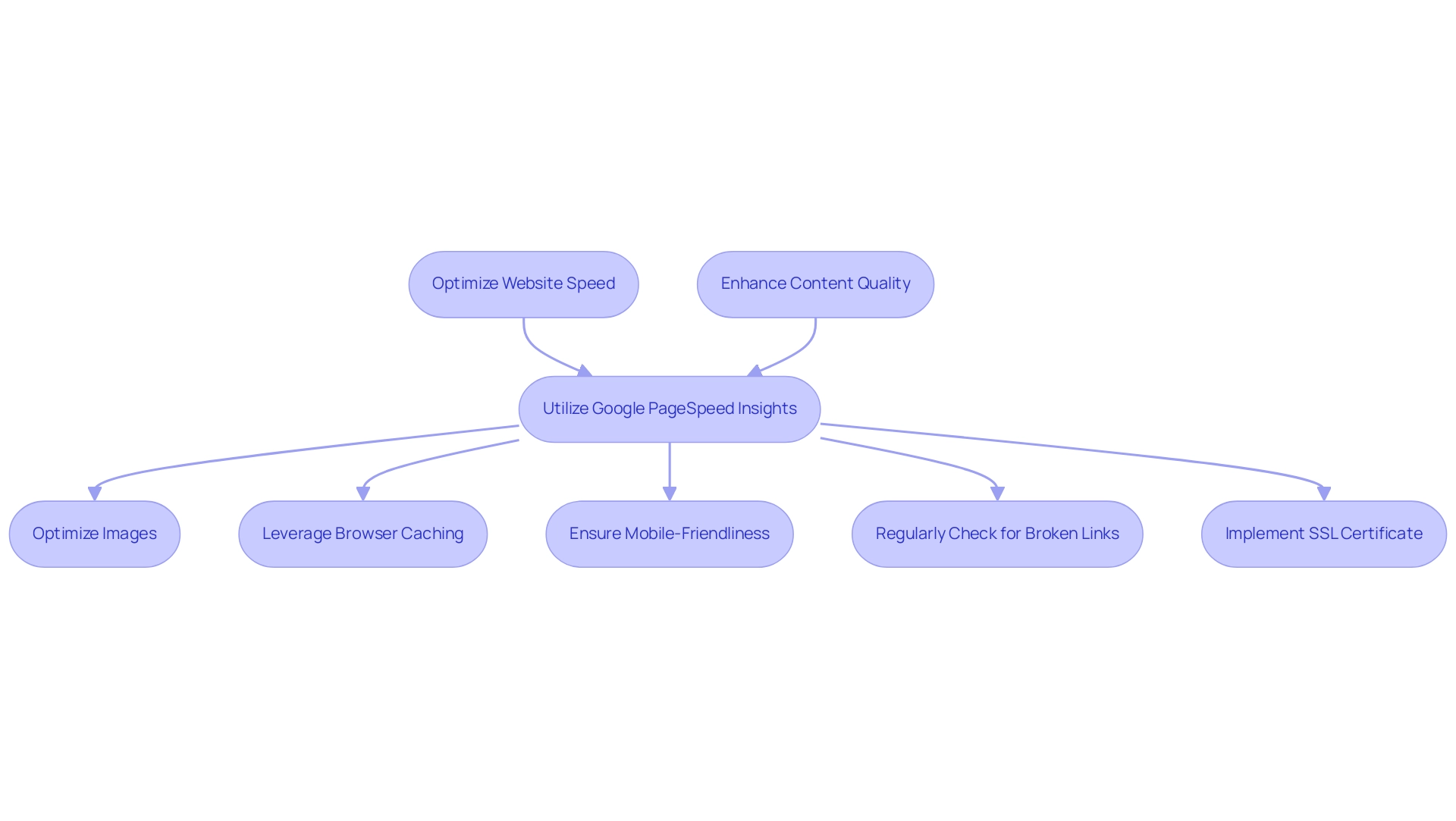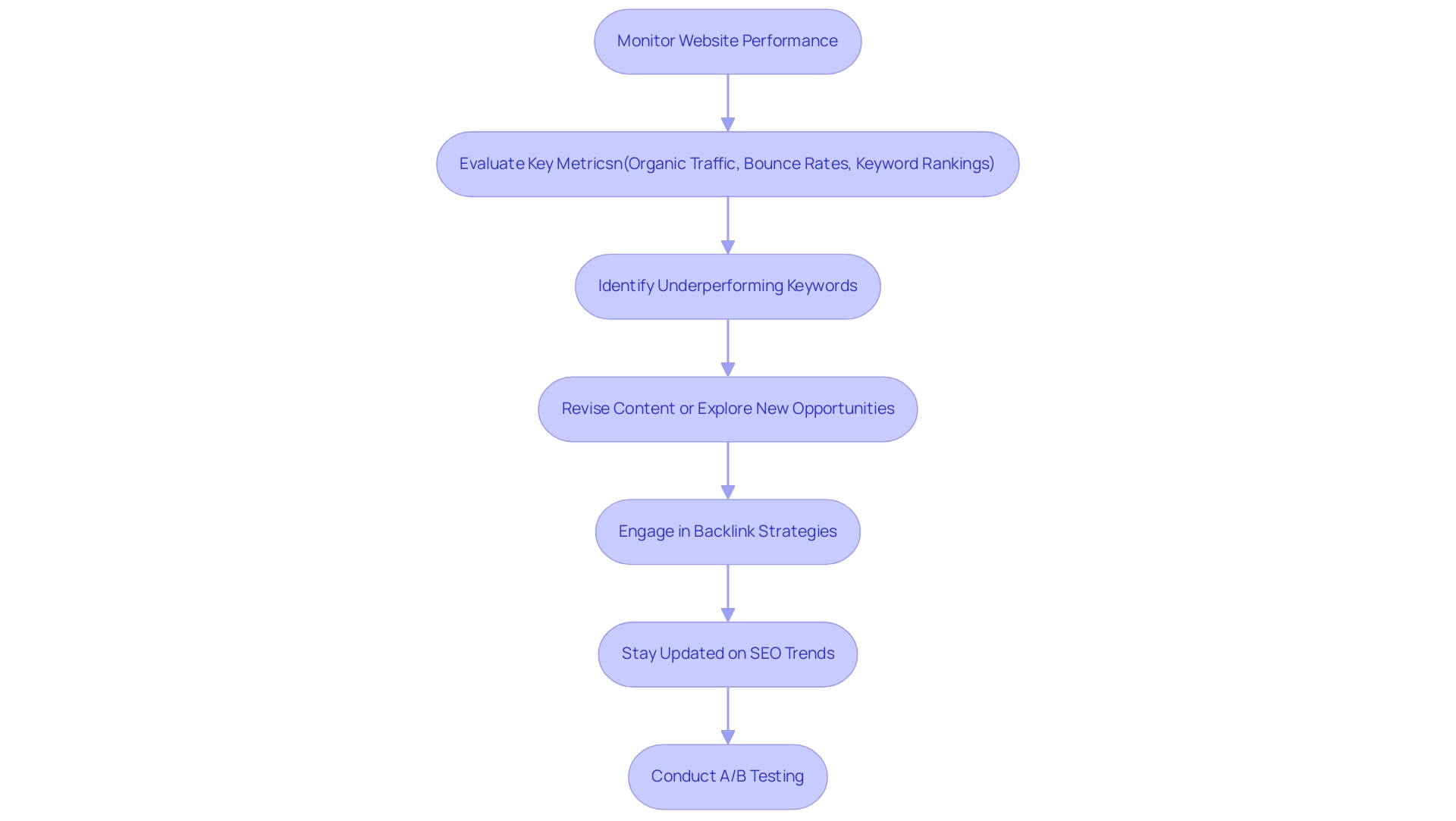Introduction
In the competitive landscape of healthcare, establishing a robust online presence is paramount for attracting and retaining patients. Effective search engine optimization (SEO) is not merely an option; it is a necessity for clinics aiming to enhance visibility and credibility in an increasingly digital world.
This article delves into the essential components of SEO, including:
- Keyword research
- On-page optimization
- Building authority through backlinks
- Technical enhancements
By understanding and implementing these strategies, healthcare professionals can significantly improve their website’s performance and ensure they are meeting the needs of potential patients. As the industry evolves, staying informed about the latest trends and adapting strategies accordingly will be crucial for sustained success in the realm of digital marketing.
Understanding the Basics of SEO: Keywords and Content Quality
To effectively promote your clinic’s website and increase visibility on Google, you should understand how to get to the top of Google search by starting with comprehensive keyword research. Identifying the specific terms and phrases potential patients use when searching for healthcare services is essential. Utilizing tools such as Google Keyword Planner or SEMrush allows you to uncover relevant keywords tailored to your services.
Focus particularly on long-tail keywords, which are phrases that reflect specific services or conditions, as they often attract more targeted traffic.
Once you have established your keywords, it is crucial to ensure that your material meets high-quality standards. This involves crafting informative, well-structured articles that directly address patient needs and queries. To understand how to get to the top of Google search, focus on creating material that effectively answers users’ questions with depth and relevance.
By incorporating keywords naturally, you enhance both readability and SEO, which is essential for understanding how to get to the top of Google search while avoiding the pitfalls of keyword stuffing. This approach not only improves your ranking but also builds trust with potential patients, contributing to the overall success of your clinic’s digital presence.
Moreover, consider utilizing resources such as Direction.com, which offers a free SEO audit report to assess your website rankings. This can offer important insights into your current SEO condition and emphasize areas for enhancement.
The increasing dedication to material marketing in the medical sector is further demonstrated by the case study on heightened resource allocation for medical material. The IMARC Group predicts that medical advertising will grow from $22.4 billion in 2022 to $29.2 billion by 2028, indicating a rising awareness of the significance of high-quality material in lead generation.
Moreover, keeping updated on the latest trends in medical SEO, as mentioned in Connor Wilkins’ article ‘Lead Generation in Healthcare: Creative Ways to Increase Patient Lead Volume,’ can offer timely context for your keyword research and material strategies.
Matthew George of Ralston Architects remarked,
Our revenue tripled in just 6 months. Direction.com redefined B2B client service for us. Collaborating with a team so committed to our success is frankly inspiring.
Such testimonials emphasize the significance of strategic keyword utilization and high-quality material in driving lead generation and business growth in the healthcare sector.

Optimizing On-Page SEO: Key Strategies for Higher Rankings
To enhance on-page SEO effectively, begin by crafting engaging title tags that prominently feature your primary keywords. It is essential to keep these tags under 60 characters to guarantee full display in search results, as titles exceeding this limit may be truncated. Following this, create informative meta descriptions that summarize your material succinctly, incorporating relevant keywords; the ideal length for these descriptions is approximately 150-160 characters.
This character range guarantees that your meta descriptions are both informative and entirely visible to users.
Structuring your material with headers (H1, H2, H3) is essential for enhancing readability and assisting search engines in comprehending your hierarchy. Utilizing internal linking within your site not only guides users to related content but also enhances their overall experience and potentially increases session duration.
Furthermore, optimizing your images is vital; employ descriptive filenames and alt tags that integrate relevant keywords. This practice not only enhances accessibility but also has a positive impact on your overall SEO approach.
By following these best practices, you can significantly enhance your website’s visibility and answer the question of how do I get to the top of Google search.
Given the advancements in AI and Google’s Search Generative Experience (SGE), as highlighted in the case study ‘Anticipating Transformations with AI Automation,’ it is essential for clinic owners to adjust their approaches for 2024. Furthermore, keep in mind that 84% of B2B marketers assert that material marketing greatly enhances brand visibility, emphasizing the necessity of optimizing title tags and meta descriptions as part of a larger marketing approach. Ultimately, with the recent 33% reduction in writing positions since the launch of ChatGPT, as mentioned by Bloomberry, it’s clear that AI is transforming material creation and SEO approaches, making it crucial for clinic owners to manage these changes efficiently.

Building Authority: The Role of Backlinks and Off-Page SEO
To establish authority in the medical field, it is essential to focus on acquiring high-quality backlinks from reputable websites. One effective strategy is to create shareable materials, including comprehensive articles, infographics, and original research studies, that naturally attract links from other sites. Original research published on blogs can be particularly effective, as it often draws attention and backlinks without the need for constant outreach.
Guest blogging on reputable medical platforms not only boosts visibility but also creates valuable backlinks. According to recent insights:
- 31.1% of companies choose to outsource link building.
- 68.9% manage it in-house, indicating a diverse approach to link acquisition.
Additionally, promoting your content through social media channels can significantly increase engagement and the likelihood of shares and backlinks.
A practical example of this is seen in the case study titled ‘Encouraging Patient Reviews,’ where doctors can ask patients for feedback during appointments or through follow-up communications. This practice helps build a positive online reputation and can enhance search rankings. Monitoring your backlink profile with tools such as Ahrefs or Moz is crucial for maintaining a healthy link portfolio; this allows you to disavow any low-quality or spammy links that may negatively impact your SEO efforts.
As Josh Ternyak emphasizes, 17% of marketers in the medical field indicate that SEO efforts have positively affected employee morale, highlighting the wider influence of effective link-building methods. In 2024, it is vital to prioritize metrics you can control, such as organic rankings and conversion rates, rather than relying solely on third-party metrics like Domain Rating (DR). By implementing these strategies, you can enhance your online presence and authority within the healthcare industry.

Technical SEO Essentials: Ensuring Your Site is Google-Friendly
Optimizing your website for speed is crucial, as page load times directly impact both user experience and search rankings. Evidence suggests that sites featuring high-quality material can experience traffic boosts often ten times greater than those with less effective material, highlighting the importance of not only technical optimizations but also the quality of the material. To enhance loading times, utilize tools such as Google PageSpeed Insights to pinpoint areas needing improvement.
Strategies like optimizing images, leveraging browser caching, and ensuring mobile-friendliness through responsive design are essential for providing a seamless experience across devices. Given that mobile devices represent 53.59% of the entire search engine market share, the significance of a mobile-friendly design cannot be overstated. Additionally, it is worth noting that on average, Google AI Overviews contain 4,342 characters, suggesting that content length and quality are also key factors in SEO success.
Furthermore, maintaining site integrity is vital; regularly check for broken links and rectify them promptly. As stated by Statista, in 2020, there were 58 billion unique indexed webpages in Google search, up 38.1% in five years, illustrating the competitive landscape of SEO. Implementing an SSL certificate is also recommended, as Google prioritizes secure websites in its search results.
Implementing this combination of technical SEO best practices will be essential for understanding how do I get to the top of Google search, significantly improving your site’s visibility and traffic in 2024.

Monitoring and Adapting Your SEO Strategy for Continuous Improvement
To optimize your clinic’s online visibility and answer the question of how do I get to the top of Google search, it is essential to regularly monitor your website’s performance using tools such as Google Analytics and Google Search Console. Monitoring key metrics such as organic traffic, bounce rates, and keyword rankings will allow you to evaluate the success of your SEO approaches. Notably, statistics indicate that keywords comprising 10-15 words yield 2.62 times more clicks than their single-word counterparts, emphasizing the value of targeting longer, more specific phrases.
Furthermore, take into account that 28% of searches for something nearby lead to a purchase, emphasizing the significance of local SEO approaches for drawing in potential clients. By identifying underperforming keywords and revising your content or exploring new keyword opportunities, you can discover how do I get to the top of Google search. Engaging in backlink approaches, as highlighted by the case study showing that 67.5% of SEO experts view backlinks as a dominant ranking factor, can significantly improve your clinic’s credibility and authority online.
Staying abreast of the latest SEO trends and algorithm changes in 2024 is crucial for maintaining competitive strategies. Furthermore, engaging in A/B testing for various SEO approaches allows you to determine the most effective tactics for your target audience. By continuously refining your methods based on analytical insights and leveraging the 99% positive feedback from clients, you can achieve optimal results and enhance your clinic’s online presence.

Conclusion
Establishing a strong online presence through effective SEO strategies is vital for healthcare clinics in today’s digital landscape. By focusing on comprehensive keyword research, clinics can identify and target the specific terms potential patients use in their searches. Quality content that addresses patient needs not only boosts rankings but also builds trust, making it essential for clinics to prioritize informative and engaging material.
On-page SEO elements, such as optimized title tags, meta descriptions, and structured content, play a critical role in enhancing visibility. Additionally, building authority through high-quality backlinks and off-page SEO efforts further solidifies a clinic’s reputation in the healthcare sector. Strategic link-building and content promotion via social media can significantly improve search rankings and patient engagement.
Technical SEO must not be overlooked; optimizing site speed, ensuring mobile-friendliness, and maintaining site integrity are crucial for delivering a seamless user experience. Regular monitoring and adaptation of SEO strategies using analytical tools will allow clinics to stay competitive and responsive to evolving market demands.
Ultimately, the implementation of these SEO practices will not only improve a clinic’s online visibility but also enhance its credibility and patient acquisition efforts. As the healthcare industry continues to shift towards digital platforms, staying informed and proactive in SEO will be essential for long-term success.

